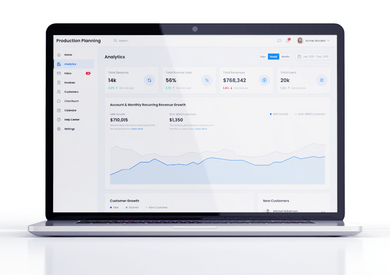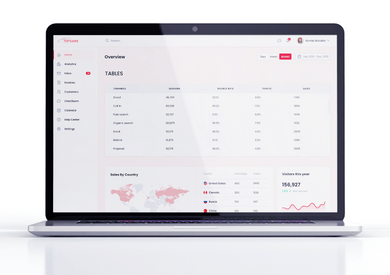Streamlining manufacturing processes by leveraging smart manufacturing software solutions and services
23 January 202404 October 2022 | Software
The growth of manufacturing solutions is driven by fast-rise technology, which encourages organizations to be more open to business automation processes in industries such as industrial manufacturing. The increase in software solutions leads to smart factories becoming the main competition driver by 2025. Furthermore, 83% of manufacturers believe that smart factories will transform how products are made. In this category, can be remembered the evolution of digital twins. This refers to the collection of technical data through which a technological representation of a physical process or product is being prototyped and tested. Organizations can simulate a product’s life cycle through digital twins, predict its behavior, and optimize its design and production system.
Table of Contents
- Business Decisions Supported by Industrial IoT Software
- Cost-effectiveness Using Management Software
- Organize Every Stage of the Manufacturing Process with Production Planning Software
- Process Automation Through Manufacturing Reporting Software
- Conclusion
Through advanced materials, smart, automated machines, and other technologies, a new era of industrial production is built. The growing connectivity, data collection, and analytics capabilities afforded through the Internet of Things (IoT) have resulted in a transition toward an information-based economy. Now, the challenge manufacturers face is how and where to invest in new technology and which ones will provide the most advantage to their businesses.
When it comes to manufacturing software development, several solutions can be implemented to improve industrial manufacturing operations. The existence of an ecosystem facilitates bringing more products and digital services to the market while reducing operational costs.

There are 4 types of ecosystems that improve operations and business processes:
- Product Ecosystem: creating products that meet customer’s requirements
- Supply Chain Ecosystem: sourcing raw materials, calibrating supply to demand, and facilitating storage and distribution of finished products to customers
- Customer Ecosystem: connecting and engaging with customers, enabling them to order products and services
- Talent Ecosystem: creating pipelines for skills and roles needed to support smart manufacturing
These types of ecosystems provide a higher capability and adaptability to the new reality on a scale. This improves not only competitiveness but also the ability to respond to disruptions more effectively. For example, through a well-built supply chain ecosystem, OEM collaborations can be created.
When it comes to the quality of production, this is measured through OEE. In industrial manufacturing, a high level of quality deliverables, together with performance and availability throughout the entire operations process, is a mix that can make a difference for a thriving business. Taking the time to analyze the losses that, in time, lead to a decrease in the OEE can help companies to make informed decisions about how to enhance their production process.
High efficiency and quality deliverables may be achieved through technologies that facilitate the replacement of physical manipulation of objects, as the industrial manufacturing sector discovered following the 2020 events. Organizations were forced by the pandemic to halt production due to the workforce’s impossibility to physically present, and together with the lack of automation led to low results on multiple levels.
At the moment, the manufacturing industry’s top objective is to raise its degree of resilience. According to surveys conducted by Mckinsey & Company, increasing the level of resilience in their supply chains is a priority for 90% of the executives. The failure of critical links in the supply chain has led to new alliances and co-development ventures between original equipment manufacturers (OEMs) and suppliers during the global pandemic, which is a clear sign that resilience in the supply chain can be built in a collaborative environment.
In this article, we will explore the smart manufacturing software ecosystem with its components, its advantages, and why they would maximize business value.
Business Decisions Supported by Industrial Iot Software
The Industrial Internet of Things (IIoT) idea has gained momentum in recent years as the value of connectivity has been more widely recognized due to increased client and consumer satisfaction and due to better production of goods and services. Both physical objects and data are sources of value, and through connectivity, it is possible to build smarter supply chains, manufacturing processes, and even end-to-end ecosystems.

IIoT stands for interconnected devices as well as technology that enables communication between linked devices and the cloud.
Using industrial IoT software, manufacturers have the chance to enhance operational strategies and achieve critical business goals by using technology at different points throughout the manufacturing value chain. Here we can include the use of collaborative robots, also known within the industry as cobots.
Cobots are more versatile than industrial robots because they are smaller and lighter, and they interact with people while working for them, not instead of them. They provide speed and precision while fostering a hybrid work environment that boosts efficiency and safety across a broad range of plant operations. Powered through industrial IoT, cobots support higher levels of cooperation and efficiency. For example, collaborative robots can process tasks such as gluing, drilling, or welding, but they are also able to finish up tasks like polishing, grinding, and deburring.
Other benefits brought by the industrial IoT software are also related to efficiency in supporting organizations to function on a better scale:
- It enables predictive maintenance: Using real-time data provided by IIoT devices, organizations may forecast when a machine will need maintenance. This approach is helping companies conduct maintenance before it even occurs. On a production line, where a machine failure might result in an interruption of work and high costs, this can be advantageous. The overall equipment effectiveness of an organization may be enhanced by proactively addressing maintenance difficulties.
- Asset tracking: Utilizing asset management systems, suppliers, manufacturers, and consumers may monitor the location, status, and condition of items across the supply chain. The system gives immediate alerts to stakeholders if items are damaged or in danger of harm, providing them the opportunity to take urgent or preventative action to rectify the problem.
- Facility management improved: Certain industrial circumstances might increase the deterioration of production equipment. Sensors can monitor vibrations, temperature, and other variables that might contribute to poor operating conditions.
Cost-effectiveness Using Management Software
Industrial manufacturing processes use cost management software to keep projects inside their originally predicted budgets. Elements like a cost estimation platform can easily keep track of costs, overall budgets, performance measuring, and reports for all the industrial manufacturing operations.

Integrated as one platform, such software will eventually provide a better overview of the costs concerning enterprise resources. The information must be easily accessible and clear to management. Usually, the most common element used in industrial manufacturing is the material bill (BOM). The bill of materials (BOM) is a detailed inventory of the raw materials, assemblies, subassemblies, parts, and components required to manufacture a product, as well as the quantities of each. Fundamentally, it is a comprehensive inventory of all the things necessary to construct a product.
“Everything was fragmented with spreadsheets, different measuring software, nothing standardized, and the information was stacked in different places: on some servers, on DropBox, on someone’s desktop, so it was very difficult to estimate a project with missing information and was no real way to know how you’d come to the tender submission that you’re at. Now, everybody estimates in the same way, with all using the same software. We all get the information from the same pricing database, it’s the same rate build-up template. All the materials info comes from a centralized point and is no deviation, really. It’s consistent time and time again, so it enables us to share works, people can take over tenders and we can tweak diffrent products. It’s not down to anyone’s individual interpretation. It’s down to the software keeping everything in the same place and estimating being twice as quick”, Jamie Brenton, Managing Director of Brebur Limited.
Jamie Brebur is a specialist SFS, dry lining, plastering, and suspended ceiling company based in Yorkshire, that delivers projects throughout England. About three years ago Jamie Brebur invested in a cost management software solution for his company.
This type of system has arisen from the natural need for automation and the facilitation of repetitive processes that can be done faster, better, and with lower costs by the computer. These programs also offer increased data protection. This results from the digitalization of information and can be omitted. Written documents can be easily lost, degraded or forgotten. Each user receives a secure account, to which only the designated people from the companies have access. It is impossible for unauthorized persons to copy, print, or transmit data by unauthorized persons.
Organize Every Stage of the Manufacturing Process with Production Planning Software
Production planning software can support every step of the manufacturing process, from determining what materials are needed to planning the workforce and keeping track of inventory. The data can be changed based on the information sent from the business, the supplier, or the plant floor. This type of software focuses on collective planning and resource allocation instead of one particular job.
According to Statista, the worldwide planning and scheduling software market was worth 1.49 billion US dollars in 2020 and is expected to grow to 2.94 billion US dollars by 2028.
This type of software solution helps organizations in planning and scheduling production based on material and manpower availability, as well as existing plant capacity. Solutions that provide manufacturers with a bird’s-eye perspective of their material flow can be developed with the help of production planning software. The material flow is optimized in terms of procedures and resources in compliance with the nature of the industry and the types of items being produced.
Without production planning, it is easy to use too much of a resource for one product and not leave enough for another or to wrongly schedule resources, which can cause delays that affect your production schedule.

Production planning software such as ERP is the best way to make sure resources are used well, products and services are high quality, and nothing goes over budget, no matter what the product or service is or how big the operation is. An SAP ERP system helps to reduce the companies’ labor costs, and IT expenses. It also improves interactions between various departments and teams, avoiding data duplication.
ERP is a modular software system that integrates a company’s business functions, such as accounting, human resources, inventory management, and buying, into a unified system. Because of this, ERP software systems are crucial for organizations since they support the implementation of well-structured resource planning by unifying all of the processes required to manage their businesses into a single system.
Process Automation Through Manufacturing Reporting Software
The manufacturing reporting software enables enterprises to automate activities such as materials planning, production monitoring, and quality control while offering real-time visibility into the plant floor activity. The benefits of robotic process automation (RPA) allow organizations to automate repetitive tasks, such as compliance reports or data entry leading to overall equipment effectiveness while also, enabling employees to focus on more valuable tasks.
Based on machine learning, the RPA provides real-time information on what has been produced, what is in progress, how much raw material is in stock, how many completed items have been transported, the total workforce utilization, and machine efficiency, among other metrics. Business decisions can be made based on live data and identify issues damaging the productivity of the operations.

Through manufacturing reporting software companies are one click away from real-time insights and reports on resources, production tracking, and quality control.
Conclusion
Having customized software for the industrial manufacturing field is beneficial due to the fact that it is created based on the business needs and it is also flexible which means that it can be changed if the business needs are shifting from the original focus. In general, manufacturing software should speed up production, cut back on operations that don’t make a profit, keep track of production, and cut down on waste.
The goal is to find the best way to plan, schedule, develop, make, and deliver goods and services. Since manufacturing software covers every part of this definition, it’s easy to see why it’s such an important part of the industry equation.
Manufacturing efficiency in the industrial area is a great goal to have, and it’s a much easier goal to reach with the right mix: Fortech’s manufacturing software development services and our client’s vision.
FortechRoxana Moldovan, Growth Manager
Described by clients as a great communicator, detail-oriented, organized, and always eager to understand their business needs to better envision the next steps towards a true partnership, Roxana is by our client’s side through their entire journey with Fortech. Throughout the collaboration, she’s their biggest advocate and supporter.
Currently, Growth Manager, Roxana Moldovan is leading Fortech’s Industrial Manufacturing Software Development strategic direction, leveraging technology to achieve the vision of Industry 4.0 and engage in smart manufacturing ecosystems to accelerate digital transformation.






